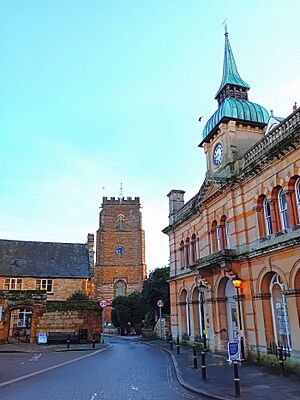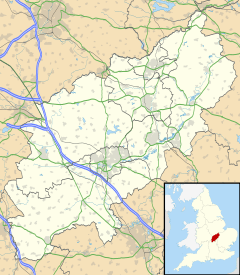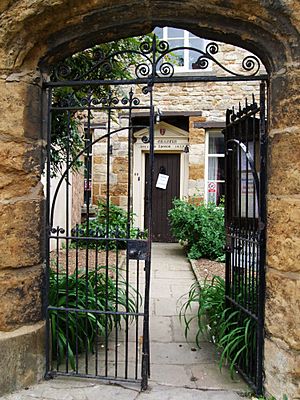Towcester facts for kids
Quick facts for kids Towcester |
|
|---|---|
 St Lawrence's Church and Towcester Town Hall |
|
| Population | 11,542 (2021 Census) |
| OS grid reference | SP691481 |
| • London | 57 miles (92 km) SE |
| Civil parish |
|
| Unitary authority |
|
| Ceremonial county | |
| Region | |
| Country | England |
| Sovereign state | United Kingdom |
| Post town | TOWCESTER |
| Postcode district | NN12 |
| Dialling code | 01327 |
| Police | Northamptonshire |
| Fire | Northamptonshire |
| Ambulance | East Midlands |
| EU Parliament | East Midlands |
| UK Parliament |
|
Towcester (pronounced TOH-ster) is a historic market town in Northamptonshire, England. It is part of the West Northamptonshire area. For many years, until 2021, it was the main office for the South Northamptonshire district.
Towcester is one of the oldest places in England where people have lived continuously. It was once a Roman town called Lactodurum. This town was built along Watling Street, which is now the A5 road. During Saxon times, Towcester was a border town between two important areas: the kingdom of Wessex and the Danelaw. The town is even mentioned in Charles Dickens's famous book, The Pickwick Papers. Today, the local racecourse is well-known for its horse racing events.
Contents
What Does the Name Towcester Mean?
The name Towcester comes from an old English word, Tōfeceaster. The first part, Tōfe, refers to the River Tove that flows nearby. The second part, ceaster, comes from the Latin word castra, which means "camp." This word was often used for places in Britain that used to be Roman army camps. So, Towcester means "Camp on the River Tove."
A Look Back in Time: Towcester's History
How Old Is Towcester?
Towcester is thought to be the oldest town in Northamptonshire. It might even be one of the oldest places in the country where people have always lived. This is because archaeologists have found very old items from the British Iron Age in the town. There is also proof that people lived here as far back as the Mesolithic era, which is the middle stone age. Iron Age burials have also been found in the area.
Towcester in Roman Times
During the time of Roman Britain, the Romans built Watling Street (now the A5 road) right through this area. They also set up a military town called Lactodurum where Towcester is today. Some historians believe that two places near Towcester, Church Stowe and Paulerspury, might have been where the famous Battle of Watling Street happened in 61 AD. In this battle, the Roman army fought against the British tribes led by Queen Boudica. A stone head, showing a mix of Celtic and Roman styles, was found near Watling Street outside the town. It is now in the British Museum.
Saxon and Medieval Towcester
After the Romans left Britain in the 5th century, Saxons settled in the area. By the 9th century, Watling Street became a border. It separated the kingdom of Wessex from the Danelaw, which was an area ruled by Vikings. This made Towcester an important border town. In 917, King Edward the Elder made Towcester stronger by building defenses.
Later, in the 11th century, the Normans built a motte-and-bailey castle here. Today, you can still see the remains of this castle at Bury Mount. It is a protected ancient monument. In 2008, it was improved with a new ramp and signs to explain its history.
Towcester in the Georgian and Victorian Eras
In the 1700s and early 1800s, stagecoaches and mail coaches were very popular. Watling Street became a major road connecting London and Holyhead. Towcester became a busy stopping point, and many coaching inns were built for travelers. Many of these old inns are still there today.
However, the coaching business stopped suddenly in 1838. This happened when the London and Birmingham Railway opened. The railway line did not go through Towcester, but through a nearby town called Blisworth. This caused Towcester to become a quiet market town again.
Later, in 1866, Towcester finally got its own railway connection. It became part of the Stratford Junction Railway. From Towcester railway station, people could travel in four different directions. However, these railway lines eventually closed. The last passenger trains stopped running in 1952, and all goods traffic ended in 1964. The site of the old Towcester railway station is now a Tesco supermarket.
Towcester in the 20th Century and Today
During the Second World War, many children from London were sent to Towcester for safety. The government thought the town was far enough from big cities that might be bombed. Towcester was bombed twice, but it did not suffer major damage.
The rise of cars brought new life to the town. While the A43 road now goes around Towcester, the A5 road still runs through the town center. This can cause traffic jams and pollution. To help with this, a new relief road connecting the A5 to the A43 was completed to the south of the town in 2025. This helps reduce traffic in the town center.
Towcester has grown a lot. In 1961, about 2,700 people lived here. By 2011, the population was over 9,200. The town continues to expand, with plans for even more homes.
Where is Towcester Located?
Towcester is about 10 miles southwest of Northampton and 11 miles northwest of Milton Keynes. Oxford is about 20 miles to the southwest. The A43 road now bypasses the town to the north. However, the A5 road still goes through the town center, though a new link road completed in 2025 helps reduce traffic.
The closest railway station is Northampton railway station, about 10 miles away. Buses run from Towcester to nearby towns like Northampton, Milton Keynes, and Brackley, but they are not very frequent.
How Towcester is Governed
Towcester has two levels of local government. There is the Towcester Town Council, which looks after local matters for the town. Then there is the West Northamptonshire Council, which is a larger council covering the whole area.
The Towcester Town Council is based at Towcester Town Hall on Watling Street. This building was built in 1865. The Town Hall was once used by the Towcester Rural District Council. In 1986, the local council officially declared Towcester a town, and it became the Towcester Town Council.
The South Northamptonshire District Council used to have its main office in Towcester. In 2015, they moved into a new building called The Forum. In 2021, the South Northamptonshire District Council and the Northamptonshire County Council were replaced by the new West Northamptonshire Council. The Forum is now an area office for the West Northamptonshire Council.
Since 2010, Towcester has been part of the South Northamptonshire area for national elections.
Places to Visit and Things to Do
St Lawrence's Church
Saint Lawrence's Church is in the middle of Towcester. Its oldest parts date back to the 12th century. The church was rebuilt between 1480 and 1485, and the church tower was added then. The tower has 12 bells, which are considered some of the best in the Midlands. The church also has a special old Bible called a "Treacle" Bible.
The church is linked to Archdeacon Sponne, who was a rector there from 1422 to 1448. He started one of the oldest grammar schools in the United Kingdom. This school later joined with the local secondary school to become Sponne School.
Towcester Mill
Towcester Mill, located on Chantry Lane, has been around for a very long time. It was even mentioned in the Domesday Book in 1086. The oldest part of the building that still stands is over 200 years old. The mill used water power to grind corn into flour and mix animal feed. It is believed to be the only water mill in Northamptonshire that still has a working turbine.
Other Local Attractions
Just outside Towcester, in Slapton, you can find The Slapton Wall Paintings. These are beautiful old paintings from the 14th and 15th centuries inside the Church of St Botolph.
Towcester also has an Air Cadet squadron and a local scouts and guides group. The Towcester Museum tells the story of the town's past. For outdoor fun, there's a wetland park, two small "pocket parks," and a main park called The Recreation Ground, known as "The Rec."
Sports in Towcester
Towcester Racecourse is on the east side of town. It has hosted many national horse racing events. In 2010, the World Hovercraft Championship was held there.
Towcester's rugby union team, Towcestrians R.F.C., plays in a high league. The town also has a cycling club, the A5 Rangers, which started in 1948.
The famous motor racing track, Silverstone Circuit, is only 5 miles away from Towcester.
Twin Towns
Towcester is twinned with Zhydachiv, a town in Ukraine. The official twinning was finalized by the Towcester Town Mayor on April 14, 2025.
Famous People from Towcester
- Sir Richard Empson (around 1450 – 1510), a minister for King Henry VII of England.
- Edward Grubb (1740–1816), a stonemason and sculptor.
- James Hutchings, a publisher.
- John Meyrick, an agriculturalist and rower who competed in the 1948 Summer Olympics.
- Elliot Parish, born in 1990, a professional footballer.
- Edward Rooker, an engraver, artist, and actor.
- David Sharp, an entomologist (someone who studies insects).
- Thomas Shepard (1605–1649), an American Puritan minister.
- Graeme Swann (born 1979), a famous cricketer.
- Joshua Steele (born 1989), a DJ.
Towcester in Books and TV
In Charles Dickens's novel The Pickwick Papers, the "Saracen's Head Inn" in Towcester is one of the places where Mr. Pickwick stops on his journey along what is now the A5 road.
Towcester is also briefly mentioned in the BBC television show Peaky Blinders. In one episode, a character says: "Mr Sabini, if you think they're planning to fix Northern races, we'll take no more bets on anything north of Towcester."
See also
 In Spanish: Towcester para niños
In Spanish: Towcester para niños





